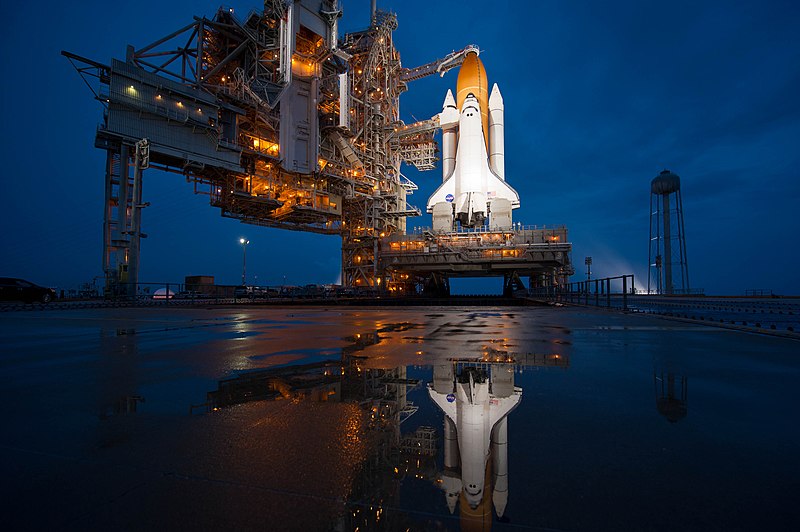Did You Know? The Space Shuttle Ran On Only One Megabyte Of RAM!

It’s true! NASA’s space shuttle was controlled by a computer running on only one megabyte of RAM. How was this possible? Since the space shuttle and all its hardware was over 30 years old during its last flight in 2011, so was its computer. That computer was actually an upgraded version of the 500-kilobyte computer that was used until 1991, but still based on the same outdated technology from the 1980s.
How did the space shuttle work on only one megabyte of RAM?
So how did the computer process all those complex calculations with only one megabyte of RAM? Well, the shuttle, unlike the average modern computer, didn’t need a complex graphical user interface and all the fancy programs and games we use. All it did was process the raw data it got from all the sensors and coordinate the shuttle’s functions, in a simple UNIX-like environment. True, all those calculations were complex, but they didn’t require a more powerful computer than they already had.
Why wasn’t the space shuttle upgraded?
Still, why weren’t the old computers replaced with newer ones? As the popular saying goes, don’t repair what’s not broken. If new computer systems were to be installed, they would require massive testing until they were nearly 100% fail-proof. You wouldn’t want to get a “Blue Screen Of Death” in the middle of a launch, would you? And during the past 30 years the computer system performed nearly-flawlessly. Another reason would be NASA’s budget constraints. Why spend money on something that’s working well anyways, instead of doing something useful in space?

Similarly, the Russian Soyuz capsule’s computer ran on only 6 kilobytes of RAM until it was replaced with newer systems in 2003, which most probably was the cause of its subsequent non controlled descent in Kazakhstan. Thankfully the crew survived.
When newer space launch technology replaced the space shuttle it included more recent computer systems, since they had to design the whole thing from scratch anyway.
Originally published on March 27, 2010. Last updated on February 9, 2023.
Would you like to receive similar articles by email?






30 Comments
Fregatepallada
Soyuz DM did not crash landed in 2003. Yes it experienced anomaly and non controlled descent but crew survived landing.
Paul Tomaszewski
Yes, you are correct. Still, crash landing implies it landed, not blew up in the atmosphere.
But I guess “non controlled descent” is a much better way of putting it.
P. M.
It’s amazing to think that you can get in to outer space only using 1Gb ram, on earth that cannot process the most basic programmes
Paul Tomaszewski
Actually it’s 1 MB of RAM not 1 GB, which is 1024 times less. 😛 If you get rid of all the fancy graphics and have only a text-based user interface, then you can easily fit with only 1 MB, even for large tasks such as running a space shuttle. In fact, I’ve written many programs that only use a few KB of RAM, which is a small fraction of the 1 MB the space shuttle has. (I am studying computer science in college.)
Jessie
Wow I’ve learned a lot from this post. It’s just so amazing that a 1 megabyte RAM could turn the world’s technology into its current state now. This is just so priceless.
Luke
Well it uses that it needs.
Get rid of fancy graphics, and applications and see what power you need ? Not much…
Hollywood and Video Games and Design Applications – that where all the cpu development is needed.
And we dont even need so much more power to what we are offered.
More power – less code optimization.
Not so much better graphics today requires gazillions of CPU and memory more….
Patricia Donovan
My Dad worked on the Apollo Program…he told me that the lunar landing was handled by 4K worth of memory!!!!
Binary ruled!
Vacatures Online
You gotta be kidding. How is is possible that some kind of space shuttle goes into space with just 1 megabyte ram? Why do i need 4GB ram?
C. C.
How is this even possible? I undertand the effects of outerspace and radiation on circuitry, but that is amazing. I wonder if there are applications being used that will eventually translate to everyday use which we are not aware of yet…hmmm.
Armstrong
How about the Eagle computer? Yes, it’s apollo XI command module to land on the moon…
Christian
Guessing your site gets a lots of visitors since the design is professional. Who’s your designer is? Feel free to email me.
Bob
My first computer ran 4mb ram and 100mb hard drive in 1995. I designed complex websites. I used to have to write the code, shut down notepad and open Netscape to check it, then shut down Netscape and open notepad to make changes. Multitasking at its best!
SuperSparky
Outer space is not friendly to semiconductors. Cosmic rays just love to wreak havoc with electronics. The smaller the circuit pathway is, the more susceptible to damage and failure it is.
So, all of that fancy schmancy high speed silicon you have in your gaming PC is more likely to be turned into worthless Swiss cheese by sub atomic particles traveling near the speed of light than an old, but reliable set of circuits with a large per-transistor footprint on a wafer.
Think of it this way, placing an Intel Core i7 at 3.3GHz and 16 GB of RAM in space is the same as placing a Ferrari in a monster truck rally.
Andreas
Thats realy awesome.
Only 1MB Ram…
And that the Soyuz capsule’s only need 6 kb is heavy
Hermitbiker
…. incredible, 1mb of ram does it all…. yep, if it’s not broke ~ don’t fix the damn thing !! 🙂
Jason
Nasa confirmed that the next Space Shuttle Computer system will be built using AMD Phenom II Quad processor and ATI Radeon 5790 graphics card supporting DirectX 11
The Control console of shuttle will be fully GUI. As there is a wait time before astronauts get into space after liftoff, NASA ha splanned ot load some recreational games such as COD WM 2 so astronauts can play them while sitting ideal
Paul Tomaszewski
Thank you all for your comments! 😀
michael
At the time it was designed, 500k of ram was really pushing the envelope.
vic K.
The computers on the space shuttle do not have to play video games which require more powerful hardware every year.
They just needed basic graphics and trajectories.(the space capsules got it right).
Mikkel
I believe you’re right in some sense, but other times, having to save a few cpu cycles or memory access means jumping through various hoops, and in the end this can result in complex code.
Randyy
Yup. The Voyager 2, which is now 8.5 billion miles out (twice the distance from the moon to Pluto), is run by a CPD1802. So was the COSMAC ELF computer that I build around 1979 from a Popular Electronics construction article. A great little processor. My self-designed OS took about 60 bytes, my memory dialer program about 68 bytes, and the data another 128 bytes for a total of 256 bytes of RAM.
Rick Cain
Well don’t worry, the Shuttle has the latest computer upgrades. They went from the 80386 chip to the 80486 CPU in the 5 redundant computer systems onboard.
drew
I took a computer science class in assembly language in college taught by a guy who used to code for the shuttle. All the code for the shuttle is written in assembly which is the most basic practical language for writing software. The idea is to build it absolutely fail proof. It has 4 computers running the same program at the same time and if one of them has an error it is kicked off line and the other three take over. It also has a fifth backup computer running a different set of code designed to do the same thing in case all four have problems it takes over.
diazamet
I know this article is supposed to make people gasp with surprise but it shouldn’t really.
The computers on the shuttle are designed with a specific purpose, to guide the shuttle. The computers essentially run one application. The application will have been designed such that the amount of memory needed will be known precisely at design-time and I’m pretty sure there’s no dynamically allocated memory 🙂
This article is like saying ‘OMG your washing machine only has 64KiB RAM’; it has the exact amount of memory required to do it’s single job.
Sam Watkins
Most “more recent computer systems” are poorly engineered over-clocked pieces of crud that would be out of place on a space shuttle or any serious hardware. An x86-powered space shuttle? I don’t think so, I wouldn’t trust it to control a car let alone a shuttle. More RAM and a more complex processor means more things that can go wrong, so yes, keep it simple.
Clovis
A teacher once told us the golden rule for his class was KISS (Keep It Simple, Stupid!). Sounds like KISS applies in this case. I’d heard of this before–I think the computer simply controls the thrusters on re-entry. There is probably more risk in upgrading it than not.
Joel P.
“Outdated technology from the 1980s”?
Try late 1970s. The first test flight was in 1981, so the computer systems were designed and built well before that.
Paul Tomaszewski
Yes you’re right. Though when they upgraded it in 1991 I think they used hardware slightly more recent than that.
Jerry
The whole point is… it doesn’t have or make errors…
Duh!
Daniel Amezcua
You would think that out of shear desire to make a system ready for errors that they would have been over doing something like this for years. Mind blowing that they haven’t!